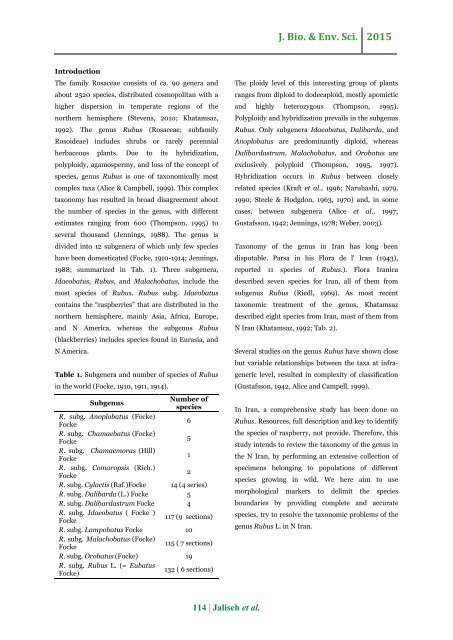A taxonomic review of Rubus L. (Rosaceae) in the Northern Iran based on the analysis of quantitative morphological characters
The genus Rubus is highly variable and frequently occurring in Iran, particularly in North regions. It has a global distribution on all climates except the Antarctic region. Ten morphological quantitative characters in seven species of Rubus in N Iran were studied. Based on the UPGMA cluster analysis of quantitative characters, the similarity of individuals was measured from 0.04 to 1. Our results showed high morphological variation among the populations.The northern Iranian Rubus populations were segregated from each other based on analysis of the quantitative morphological data. Quantitative morphological characters of the species were variable in different climatic conditions. Two species i.e. R. sanctus and R. persicus showed high rate of morphological variability in comparison to other species. Our results indicates that the morphology does not reflect the high rate of hybridization in Rubus, which is frequently reported by other researchers. Get more articles at: http://www.innspub.net/volume-6-number-3-march-2015-jbes/
The genus Rubus is highly variable and frequently occurring in Iran, particularly in North regions. It has a global distribution on all climates except the Antarctic region. Ten morphological quantitative characters in seven species of Rubus in N Iran were studied. Based on the UPGMA cluster analysis of quantitative characters, the similarity of individuals was measured from 0.04 to 1. Our results showed high morphological variation among the populations.The northern Iranian Rubus populations were segregated from each other based on analysis of the quantitative morphological data. Quantitative morphological characters of the species were variable in different climatic conditions. Two species i.e. R. sanctus and R. persicus showed high rate of morphological variability in comparison to other species. Our results indicates that the morphology does not reflect the high rate of hybridization in Rubus, which is frequently reported by other researchers. Get more articles at: http://www.innspub.net/volume-6-number-3-march-2015-jbes/
Create successful ePaper yourself
Turn your PDF publications into a flip-book with our unique Google optimized e-Paper software.
J. Bio. & Env. Sci. 2015<br />
Introducti<strong>on</strong><br />
The family <str<strong>on</strong>g>Rosaceae</str<strong>on</strong>g> c<strong>on</strong>sists <str<strong>on</strong>g>of</str<strong>on</strong>g> ca. 90 genera and<br />
about 2520 species, distributed cosmopolitan with a<br />
higher dispersi<strong>on</strong> <str<strong>on</strong>g>in</str<strong>on</strong>g> temperate regi<strong>on</strong>s <str<strong>on</strong>g>of</str<strong>on</strong>g> <str<strong>on</strong>g>the</str<strong>on</strong>g><br />
nor<str<strong>on</strong>g>the</str<strong>on</strong>g>rn hemisphere (Stevens, 2010; Khatamsaz,<br />
1992). The genus <str<strong>on</strong>g>Rubus</str<strong>on</strong>g> (<str<strong>on</strong>g>Rosaceae</str<strong>on</strong>g>; subfamily<br />
Rosoideae) <str<strong>on</strong>g>in</str<strong>on</strong>g>cludes shrubs or rarely perennial<br />
herbaceous plants. Due to its hybridizati<strong>on</strong>,<br />
polyploidy, agamospermy, and loss <str<strong>on</strong>g>of</str<strong>on</strong>g> <str<strong>on</strong>g>the</str<strong>on</strong>g> c<strong>on</strong>cept <str<strong>on</strong>g>of</str<strong>on</strong>g><br />
species, genus <str<strong>on</strong>g>Rubus</str<strong>on</strong>g> is <strong>on</strong>e <str<strong>on</strong>g>of</str<strong>on</strong>g> <str<strong>on</strong>g>tax<strong>on</strong>omic</str<strong>on</strong>g>ally most<br />
complex taxa (Alice & Campbell, 1999). This complex<br />
tax<strong>on</strong>omy has resulted <str<strong>on</strong>g>in</str<strong>on</strong>g> broad disagreement about<br />
<str<strong>on</strong>g>the</str<strong>on</strong>g> number <str<strong>on</strong>g>of</str<strong>on</strong>g> species <str<strong>on</strong>g>in</str<strong>on</strong>g> <str<strong>on</strong>g>the</str<strong>on</strong>g> genus, with different<br />
estimates rang<str<strong>on</strong>g>in</str<strong>on</strong>g>g from 600 (Thomps<strong>on</strong>, 1995) to<br />
several thousand (Jenn<str<strong>on</strong>g>in</str<strong>on</strong>g>gs, 1988). The genus is<br />
divided <str<strong>on</strong>g>in</str<strong>on</strong>g>to 12 subgenera <str<strong>on</strong>g>of</str<strong>on</strong>g> which <strong>on</strong>ly few species<br />
have been domesticated (Focke, 1910-1914; Jenn<str<strong>on</strong>g>in</str<strong>on</strong>g>gs,<br />
1988; summarized <str<strong>on</strong>g>in</str<strong>on</strong>g> Tab. 1). Three subgenera,<br />
Idaeobatus, <str<strong>on</strong>g>Rubus</str<strong>on</strong>g>, and Malachobatus, <str<strong>on</strong>g>in</str<strong>on</strong>g>clude <str<strong>on</strong>g>the</str<strong>on</strong>g><br />
most species <str<strong>on</strong>g>of</str<strong>on</strong>g> <str<strong>on</strong>g>Rubus</str<strong>on</strong>g>. <str<strong>on</strong>g>Rubus</str<strong>on</strong>g> subg. Idaeobatus<br />
c<strong>on</strong>ta<str<strong>on</strong>g>in</str<strong>on</strong>g>s <str<strong>on</strong>g>the</str<strong>on</strong>g> “raspberries” that are distributed <str<strong>on</strong>g>in</str<strong>on</strong>g> <str<strong>on</strong>g>the</str<strong>on</strong>g><br />
nor<str<strong>on</strong>g>the</str<strong>on</strong>g>rn hemisphere, ma<str<strong>on</strong>g>in</str<strong>on</strong>g>ly Asia, Africa, Europe,<br />
and N America, whereas <str<strong>on</strong>g>the</str<strong>on</strong>g> subgenus <str<strong>on</strong>g>Rubus</str<strong>on</strong>g><br />
(blackberries) <str<strong>on</strong>g>in</str<strong>on</strong>g>cludes species found <str<strong>on</strong>g>in</str<strong>on</strong>g> Eurasia, and<br />
N America.<br />
Table 1. Subgenera and number <str<strong>on</strong>g>of</str<strong>on</strong>g> species <str<strong>on</strong>g>of</str<strong>on</strong>g> <str<strong>on</strong>g>Rubus</str<strong>on</strong>g><br />
<str<strong>on</strong>g>in</str<strong>on</strong>g> <str<strong>on</strong>g>the</str<strong>on</strong>g> world (Focke, 1910, 1911, 1914).<br />
Subgenus<br />
R. subg. Anoplobatus (Focke)<br />
Focke<br />
R. subg. Chamaebatus (Focke)<br />
Focke<br />
R. subg. Chamaemoras (Hill)<br />
Focke<br />
R. subg. Comaropsis (Rich.)<br />
Focke<br />
R. subg. Cylactis (Raf.)Focke<br />
R. subg. Dalibarda (L.) Focke<br />
R. subg. Dalibardastrum Focke<br />
R. subg. Idaeobatus ( Focke )<br />
Focke<br />
R. subg. Lampobatus Focke<br />
R. subg. Malachobatus (Focke)<br />
Focke<br />
R. subg. Orobatus (Focke)<br />
R. subg. <str<strong>on</strong>g>Rubus</str<strong>on</strong>g> L. (= Eubatus<br />
Focke)<br />
Number <str<strong>on</strong>g>of</str<strong>on</strong>g><br />
species<br />
6<br />
5<br />
1<br />
2<br />
14 (4 series)<br />
5<br />
4<br />
117 (9 secti<strong>on</strong>s)<br />
10<br />
115 ( 7 secti<strong>on</strong>s)<br />
19<br />
132 ( 6 secti<strong>on</strong>s)<br />
The ploidy level <str<strong>on</strong>g>of</str<strong>on</strong>g> this <str<strong>on</strong>g>in</str<strong>on</strong>g>terest<str<strong>on</strong>g>in</str<strong>on</strong>g>g group <str<strong>on</strong>g>of</str<strong>on</strong>g> plants<br />
ranges from diploid to dodecaploid, mostly apomictic<br />
and highly heterozygous (Thomps<strong>on</strong>, 1995).<br />
Polyploidy and hybridizati<strong>on</strong> prevails <str<strong>on</strong>g>in</str<strong>on</strong>g> <str<strong>on</strong>g>the</str<strong>on</strong>g> subgenus<br />
<str<strong>on</strong>g>Rubus</str<strong>on</strong>g>. Only subgenera Idaeobatus, Dalibarda, and<br />
Anoplobatus are predom<str<strong>on</strong>g>in</str<strong>on</strong>g>antly diploid, whereas<br />
Dalibardastrum, Malachobatus, and Orobatus are<br />
exclusively polyploid (Thomps<strong>on</strong>, 1995, 1997).<br />
Hybridizati<strong>on</strong> occurs <str<strong>on</strong>g>in</str<strong>on</strong>g> <str<strong>on</strong>g>Rubus</str<strong>on</strong>g> between closely<br />
related species (Kraft et al., 1996; Naruhashi, 1979,<br />
1990; Steele & Hodgd<strong>on</strong>, 1963, 1970) and, <str<strong>on</strong>g>in</str<strong>on</strong>g> some<br />
cases, between subgenera (Alice et al., 1997;<br />
Gustafss<strong>on</strong>, 1942; Jenn<str<strong>on</strong>g>in</str<strong>on</strong>g>gs, 1978; Weber, 2003).<br />
Tax<strong>on</strong>omy <str<strong>on</strong>g>of</str<strong>on</strong>g> <str<strong>on</strong>g>the</str<strong>on</strong>g> genus <str<strong>on</strong>g>in</str<strong>on</strong>g> <str<strong>on</strong>g>Iran</str<strong>on</strong>g> has l<strong>on</strong>g been<br />
disputable. Parsa <str<strong>on</strong>g>in</str<strong>on</strong>g> his Flora de l' <str<strong>on</strong>g>Iran</str<strong>on</strong>g> (1943),<br />
reported 11 species <str<strong>on</strong>g>of</str<strong>on</strong>g> <str<strong>on</strong>g>Rubus</str<strong>on</strong>g>.). Flora <str<strong>on</strong>g>Iran</str<strong>on</strong>g>ica<br />
described seven species for <str<strong>on</strong>g>Iran</str<strong>on</strong>g>, all <str<strong>on</strong>g>of</str<strong>on</strong>g> <str<strong>on</strong>g>the</str<strong>on</strong>g>m from<br />
subgenus <str<strong>on</strong>g>Rubus</str<strong>on</strong>g> (Riedl, 1969). As most recent<br />
<str<strong>on</strong>g>tax<strong>on</strong>omic</str<strong>on</strong>g> treatment <str<strong>on</strong>g>of</str<strong>on</strong>g> <str<strong>on</strong>g>the</str<strong>on</strong>g> genus, Khatamsaz<br />
described eight species from <str<strong>on</strong>g>Iran</str<strong>on</strong>g>, most <str<strong>on</strong>g>of</str<strong>on</strong>g> <str<strong>on</strong>g>the</str<strong>on</strong>g>m from<br />
N <str<strong>on</strong>g>Iran</str<strong>on</strong>g> (Khatamsaz, 1992; Tab. 2).<br />
Several studies <strong>on</strong> <str<strong>on</strong>g>the</str<strong>on</strong>g> genus <str<strong>on</strong>g>Rubus</str<strong>on</strong>g> have shown close<br />
but variable relati<strong>on</strong>ships between <str<strong>on</strong>g>the</str<strong>on</strong>g> taxa at <str<strong>on</strong>g>in</str<strong>on</strong>g>frageneric<br />
level, resulted <str<strong>on</strong>g>in</str<strong>on</strong>g> complexity <str<strong>on</strong>g>of</str<strong>on</strong>g> classificati<strong>on</strong><br />
(Gustafss<strong>on</strong>, 1942, Alice and Campell, 1999).<br />
In <str<strong>on</strong>g>Iran</str<strong>on</strong>g>, a comprehensive study has been d<strong>on</strong>e <strong>on</strong><br />
<str<strong>on</strong>g>Rubus</str<strong>on</strong>g>. Resources, full descripti<strong>on</strong> and key to identify<br />
<str<strong>on</strong>g>the</str<strong>on</strong>g> species <str<strong>on</strong>g>of</str<strong>on</strong>g> raspberry, not provide. Therefore, this<br />
study <str<strong>on</strong>g>in</str<strong>on</strong>g>tends to <str<strong>on</strong>g>review</str<strong>on</strong>g> <str<strong>on</strong>g>the</str<strong>on</strong>g> tax<strong>on</strong>omy <str<strong>on</strong>g>of</str<strong>on</strong>g> <str<strong>on</strong>g>the</str<strong>on</strong>g> genus <str<strong>on</strong>g>in</str<strong>on</strong>g><br />
<str<strong>on</strong>g>the</str<strong>on</strong>g> N <str<strong>on</strong>g>Iran</str<strong>on</strong>g>, by perform<str<strong>on</strong>g>in</str<strong>on</strong>g>g an extensive collecti<strong>on</strong> <str<strong>on</strong>g>of</str<strong>on</strong>g><br />
specimens bel<strong>on</strong>g<str<strong>on</strong>g>in</str<strong>on</strong>g>g to populati<strong>on</strong>s <str<strong>on</strong>g>of</str<strong>on</strong>g> different<br />
species grow<str<strong>on</strong>g>in</str<strong>on</strong>g>g <str<strong>on</strong>g>in</str<strong>on</strong>g> wild. We here aim to use<br />
<strong>morphological</strong> markers to delimit <str<strong>on</strong>g>the</str<strong>on</strong>g> species<br />
boundaries by provid<str<strong>on</strong>g>in</str<strong>on</strong>g>g complete and accurate<br />
species, try to resolve <str<strong>on</strong>g>the</str<strong>on</strong>g> <str<strong>on</strong>g>tax<strong>on</strong>omic</str<strong>on</strong>g> problems <str<strong>on</strong>g>of</str<strong>on</strong>g> <str<strong>on</strong>g>the</str<strong>on</strong>g><br />
genus <str<strong>on</strong>g>Rubus</str<strong>on</strong>g> L. <str<strong>on</strong>g>in</str<strong>on</strong>g> N <str<strong>on</strong>g>Iran</str<strong>on</strong>g>.<br />
114 | Jaliseh et al.


















